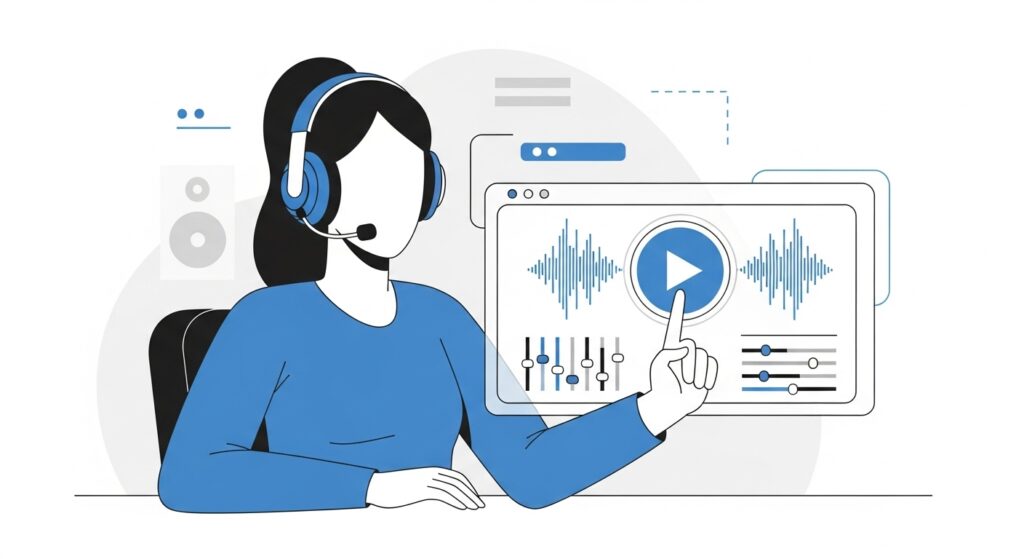Australia is buzzing with voices and stories. It’s the world of podcasts, webinars, social media reels, and news videos, and we’re all living in it. These forms of media are heavily consumed by us because of their engaging and powerful nature. However, not everybody can easily access audio or video content. Some may have hearing difficulties, while others might prefer a written summary for added convenience.
This is where audio and video transcription becomes a game-changer. It makes sure every important word is captured and available in written form, no matter the language or accent. So, how does it make content accessible for everybody? Let’s break it down.
What is Audio and Video Transcription?
Audio and video transcription is simply the process of converting spoken words from audio or video files into written text. This can be used for anything from conference calls and work meetings to court hearings and patient interviews. In Australia, this is especially important as our multicultural society speaks many languages and has many unique local accents.
There are two main types of transcription services:
1. Verbatim Transcription: This is a word-for-word copy of everything that was said, including non-verbal sounds like “mmm-hmmm”, “uh”, and even laughs. It is perfect for research and legal settings where every detail might matter.
2. Intelligent Transcription: This version cleans up the speech, removing fillers and distracting noises, to make the transcript more readable. It’s great for business use or when a clean summary is needed without excess noise.
How Does Transcription Make Content Accessible?
Australians are socially diverse, with many cultures, languages, and communities. There are also people with hearing impairments, those for whom English isn’t their first language, and folks in remote or rural areas where access to resources can be trickier. Transcription helps bridge gaps in accessibility and inclusion. Here’s how it makes content accessible to all audiences:
1. Accessibility for the Deaf and Hard-of-Hearing
In our society, making sure everyone can access content is a basic value. Transcripts let those who are deaf or hard of hearing follow online talks, podcasts, or news videos. Instead of trying to lip-read or guess, they can read exactly what is said.
2. Multicultural Australia and Multilingual Needs
Australia has a large population of immigrants and multilingual people. Many first languages other than English are spoken at home. Transcripts help non-native English speakers follow along more easily. They can pause, re-read, and look up words. It improves comprehension and learning.
3. Remote and Regional Access
People in rural and remote parts of Australia might have spotty internet or limited data. Video streaming is heavy on bandwidth; text is lighter. A transcript lets people still access content without the need for perfect video quality.
4. Education & Research
From university lectures to school assignments, transcription helps students and researchers. Say a lecturer records a seminar: a transcript means students can revisit what was said, quote correctly, and search for key terms. In social sciences, interviews and focus groups are often transcribed for analysis. Accuracy matters.
5. Legal, Medical, and Government Requirements
There are formal settings where written records are essential. In court hearings, patient interviews, and council meetings, transcripts are part of the archival record, compliance, or liability purposes.
6. Searchability and SEO
For businesses, media outlets, and creators, having text behind video/audio content helps search engines find your material. If you have a video on your website, pairing it with a transcript means people can search inside the content. More people find it, which leads to more reach.
7. Better Engagement and Usability
Some people prefer to skim or scan text. Transcripts help them quickly find what’s relevant, rather than watching an entire video. Sometimes it’s more convenient, especially when reading on a commute, in a noisy place, or where video/audio isn’t an option.
What Modern Transcription Includes
Here’s what modern transcription comprises:
- Accurate text conversion of all spoken content
- Timestamps for easy navigation
- Speaker identification for multi-person conversations
- Sound descriptions for complete accessibility
- Formatting for easy reading and reference
In Australia, transcription services have evolved far beyond basic typing. This has made digital content truly accessible to everyone.
Why Choose Beyond Translation for Transcription Services?

Beyond Translation is a Melbourne-based translation company that offers guarantees behind their work, making sure you get accurate, timely results that meet your specific needs. Here’s why you should opt for their services:
1. Quality, Confidentiality, and Support
For sensitive matters, especially in legal or medical settings, confidentiality is crucial. Beyond Translation treats every file with professional care, guaranteeing privacy, no hidden fees, and a clear promise for on-time delivery. They offer 24/7 support and after-sales service, reassuring customers that their needs will be handled promptly and with respect.
2. Professional and Expert Translators
Australia is a richly diverse country, with hundreds of communities speaking many languages and dialects. Beyond Translation understands not just the words, but the Australian context. This means they can handle Aussie slang, different regional accents, and unique cultural references that automated software might miss.
3. Cutting Edge Technology with Human Touch
While technology like AI can help process audio and video, only a human expert can truly understand the subtle cues, emotions, and nuances in Australian speech. Experts at Beyond Translation combine cutting-edge tech with professional linguists, which leads to transcriptions that are both accurate and readable.
Final Thoughts
The role of audio and video translation in digital accessibility isn’t limited to following rules or ticking boxes. It’s also about creating a more inclusive Australia where everyone can access and benefit from digital content. Transcription helps make digital content accessible, clear, and useful for every individual.
If you’re a small business owner, educator, or content creator, embracing transcription services means embracing a future where new technology truly serves everyone. So, what are you waiting for? Connect with Beyond Translation today and make content consumption easier than ever before!